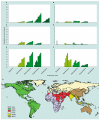The global distribution and population at risk of malaria: past, present, and future
- PMID: 15172341
- PMCID: PMC3145123
- DOI: 10.1016/S1473-3099(04)01043-6
The global distribution and population at risk of malaria: past, present, and future
Abstract
The aim of this review was to use geographic information systems in combination with historical maps to quantify the anthropogenic impact on the distribution of malaria in the 20th century. The nature of the cartographic record enabled global and regional patterns in the spatial limits of malaria to be investigated at six intervals between 1900 and 2002. Contemporaneous population surfaces also allowed changes in the numbers of people living in areas of malaria risk to be quantified. These data showed that during the past century, despite human activities reducing by half the land area supporting malaria, demographic changes resulted in a 2 billion increase in the total population exposed to malaria risk. Furthermore, stratifying the present day malaria extent by endemicity class and examining regional differences highlighted that nearly 1 billion people are exposed to hypoendemic and mesoendemic malaria in southeast Asia. We further concluded that some distortion in estimates of the regional distribution of malaria burden could have resulted from different methods used to calculate burden in Africa. Crude estimates of the national prevalence of Plasmodium falciparum infection based on endemicity maps corroborate these assertions. Finally, population projections for 2010 were used to investigate the potential effect of future demographic changes. These indicated that although population growth will not substantially change the regional distribution of people at malaria risk, around 400 million births will occur within the boundary of current distribution of malaria by 2010: the date by which the Roll Back Malaria initiative is challenged to halve the world's malaria burden.
Figures






References
-
- Russell PF. Man’s mastery of malaria. Oxford University Press; Oxford: 1955.
-
- Wiesenfeld SL. Sickle-cell trait in human biological and cultural evolution. Science. 1967;157:1134–40. - PubMed
-
- Coluzzi M. The clay feet of the malaria giant and its African roots: hypotheses and inferences about origin, spread and control of Plasmodium falciparum. Parassitologia. 1999;41:277–83. - PubMed
-
- Joy DA, Feng XR, Mu JB, et al. Early origin and recent expansion of Plasmodium falciparum. Science. 2003;300:318–21. - PubMed
-
- Hume JCC, Lyons EJ, Day KP. Human migration, mosquitoes and the evolution of Plasmodium falciparum. Trends Parasitol. 2003;19:144–49. - PubMed
Publication types
MeSH terms
Grants and funding
LinkOut - more resources
Full Text Sources
Other Literature Sources
Medical
Miscellaneous

